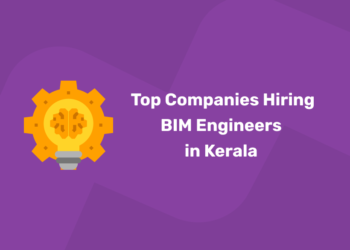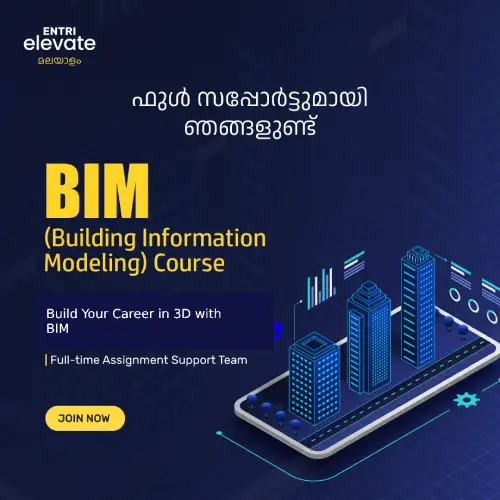Table of Contents
If you’ve just finished your engineering degree, learning BIM can be a huge boost to your career. It helps you understand how real projects are planned and built using 3D models and data. With BIM skills, you can work better with teams, avoid costly mistakes and complete projects faster and more accurately. In this blog we will explore the top 7 reasons why doing a BIM course after an engineering degree can set you apart, open up new job opportunities and prepare you for the future of the AEC (Architecture, Engineering and Construction) industry.
Get Career-Oriented BIM Certification Course with Expert Mentors! Get a free demo here!
Introduction
The engineering world is changing quicker than ever, and technology is on the heart of this variation. One of the most powerful tools driving this change is Building Information Modeling (BIM). BIM isn’t always just any other software – it’s far a clever virtual technique that allows engineers, architects and construction experts plan, layout, visualize and efficiently manage projects. Instead of working with 2D drawings, BIM permits groups to create detailed three-D models that consist of all of the important records approximately a building – from materials and shape to strength use and upkeep.
What makes BIM quite simply innovative is the way it connects all parts of the production mission. In traditional workflow, each branch did one job at a time – architects designed, engineers analyzed and contractors constructed. But with BIM, everyone works collectively on a shared virtual version, making collaboration seamless and communication clear. This allows reduce layout mistakes, save you high priced remodel, and make certain that each level of the mission stays on schedule and within price range.
BIM is transforming the whole AEC (Architecture, Engineering, and Construction) industry by means of enhancing coordination and boosting productiveness. Projects that use BIM are extra correct, sustainable, and green, making it the desired method for modern production worldwide. Many governments and agencies have even made BIM obligatory for public infrastructure initiatives, displaying how essential it has end up for the enterprise’s destiny.
For engineering graduates, getting to know BIM is one of the smartest profession actions you could make. Engineers with BIM abilities are noticeably in demand because they are able to paintings with superior digital equipment, control real-world challenges greater correctly, and bring innovation to each undertaking. A BIM course after engineering no longer simplest enhances your technical know-how however additionally prepares you for a destiny-equipped career in a discipline that’s hastily shifting towards digital transformation.
What Is BIM and How It Works?
Building Information Modeling (BIM) is more than just 3D modeling – it is a smart digital process that brings together all parts of a building project. It allows engineers, architects and contractors to create a virtual model of a building before it is built. This model is not just about shapes or design; It also contains detailed information on materials, composition, cost and performance.
In other words, BIM turns your design into a data-rich model that shows how every element – from walls and windows to plumbing and electrical systems – fits and works together in real life.
How BIM Helps Teams Work Together
The biggest advantage of BIM is collaboration. In traditional construction projects, different teams often work separately, leading to confusion and design conflicts. BIM changes this by creating a shared digital platform where everyone – engineers, architects and builders – can access the same project model in real time.
This teamwork helps:
- Avoid mistakes by detecting design conflicts early.
- Save time and money by improving coordination between teams.
- Increase accuracy by keeping all project data in one place.
With BIM, communication becomes easier, decisions are made faster, and projects run more smoothly from start to finish.
Popular BIM Software Tools
There are many powerful tools used in BIM that help professionals design and manage projects efficiently:
- Autodesk Revit: Widely used for architectural, structural and MEP (mechanical, electrical, plumbing) design. It allows users to create detailed 3D building models.
- Navisworks: Mainly used for project review, conflict detection and coordination between different teams.
- ArchiCAD: An easy-to-use BIM tool popular among architects for designing buildings and interiors.
Each of these tools helps professionals visualize, simulate and analyze construction projects – ensuring better quality and productivity.
Top 7 Reasons to Choose a BIM Course After Your Engineering Degree
The construction and engineering world is converting quicker than ever, with generation reshaping how tasks are deliberate, designed, and managed. One of the maximum powerful improvements using this transformation is Building Information Modeling (BIM). For engineering graduates, gaining knowledge of BIM isn’t simply an added skill, it’s a career funding that may set you apart in nowadays’s aggressive job market.
Reason1: High Demand for BIM Professionals
BIM Is Transforming the Construction Industry
The worldwide construction enterprise is transferring closer to virtual transformation, and Building Information Modeling (BIM) is leading this change. It helps create smarter, more correct, and green venture designs. Engineers, architects, and contractors now use BIM to devise and manage each element of a creation assignment thru digital models. This shift is making BIM one of the maximum treasured abilities within the present day engineering global.
Companies Prefer BIM-Trained Engineers
Many leading construction and engineering companies now prefer or even require candidates who are trained in BIM. These experts can effortlessly handle complicated layout workflows, perceive ability issues early, and coordinate better with multidisciplinary teams. BIM know-how gives engineers a clean aspect over others when applying for pinnacle positions in each national and global projects.
Global Adoption and Job Growth
Governments in countries like the UK, Singapore, and the UAE have made BIM mandatory for public infrastructure tasks, and this trend is spreading international. As extra businesses adopt BIM requirements, the want for skilled specialists continues to upward push.
According to industry studies, the worldwide BIM market is expected to develop at over 14% each yr, growing lots of recent BIM-related roles throughout structure, engineering, and construction firms.
A Smart Career Move for Engineers
For fresh engineering graduates, gaining knowledge of BIM is a clever funding inside the destiny. It no longer handiest makes you greater employable but additionally prepares you to work with present day virtual equipment which can be shaping the destiny of the development enterprise. With BIM skills, you’ll constantly stay in advance in a market that values innovation and efficiency.
Reason2: Better Career Opportunities and Higher Salaries
BIM Opens Doors to Specialized Roles
Learning Building Information Modeling (BIM) can significantly expand your profession alternatives after engineering. With BIM abilties, you may apply for specialised and high-demand roles including BIM Modeler, BIM Coordinator, BIM Engineer, or maybe BIM Manager as you advantage extra enjoy. These roles are crucial in current creation initiatives due to the fact they contain dealing with digital models, coordinating teams, and making sure that every part of the layout works together flawlessly.
Unlike traditional engineering jobs, BIM-based totally roles focus on era-pushed design and project control, giving you the risk to work on large, complex, and innovative initiatives worldwide. As construction companies flow in the direction of virtual workflows, they are actively seeking out experts who understand BIM equipment and approaches.
Higher Salaries for Certified BIM Professionals
Having a BIM certification no longer best improves your process possibilities however additionally enables you earn extra. Certified specialists are regularly paid better salaries because they convey superior technical and virtual information to the table. BIM specialists can help businesses keep money and time through enhancing accuracy, reducing layout errors, and streamlining assignment communication.
According to global enterprise reports, BIM-skilled engineers can earn up to 20–30% greater than the ones without BIM talents, depending on enjoy and place. Employers cost these experts because they can manage data-driven construction workflows and use equipment like Autodesk Revit, Navisworks, and ArchiCAD effectively.
A Competitive Edge in the Job Market
In these days’s rapid-changing construction industry, agencies want engineers who can assume past conventional techniques. BIM gives you that aggressive facet by using combining layout information with digital innovation. Whether you want to work in architecture, infrastructure, or undertaking management, having BIM information makes your resume stand out and will increase your chances of having hired with the aid of pinnacle corporations.
Reason 3: Enhances Technical and Design Skills
Bringing Designs to Life with 3D Visualization
One of the most powerful things about Building Information Modeling (BIM) is its ability to help engineers visualize their initiatives in 3D. Instead of working only with flat 2D drawings, engineers can now create detailed three-D models that display each part of a constructing, from the shape and substances to electrical and plumbing structures. This makes it less difficult to understand how one of a kind components fit collectively and perform in actual lifestyles.
Three-D visualization also allows engineers to present their designs clearly to clients, architects, and creation groups. Everyone involved within the task can see precisely how the final result will look, which allows avoid confusion and ensures everybody is on the same page.
Analyzing and Improving Structural Designs
BIM equipment are not just for growing visuals, in addition they permit engineers to investigate and test their designs before production begins. For instance, with BIM software program like Autodesk Revit or Navisworks, engineers can take a look at the electricity, stability, and efficiency of a shape. They can simulate actual-international situations, along with load distribution, temperature changes, or fabric performance, to make sure the design is secure and value-powerful.
This degree of analysis helps engineers make smarter design selections and pick out capability problems early within the layout degree, as opposed to during production whilst fixes can be costly and time-ingesting.
Detecting Design Errors Early
BIM is designed to catch problems earlier than they take place. By combining layout and statistics in a single version, engineers can without difficulty discover clashes or conflicts between one of a kind structures, for example, a pipe jogging via a beam or an electrical line interfering with HVAC ducts.
This early mistakes detection facilitates save each time and money, reduces transform, and improves the overall first-rate of the task. Engineers who use BIM turn out to be more correct and detail-oriented, which results in smoother creation and fewer delays.
Becoming a More Efficient and Skilled Engineer
Learning BIM enhances your technical and creative abilities on the equal time. It allows you understand how design, creation, and records come together in a single digital technique. With these abilities, you can paintings faster, produce higher-first-rate outcomes, and take on more complex initiatives confidently.
Reason 4: Boosts Collaboration and Project Management Skills
Improving Teamwork Through Shared Information
One of the best strengths of Building Information Modeling (BIM) is how it brings human beings together. In conventional construction methods, architects, engineers, and contractors regularly paintings one by one, that may cause confusion and mistakes. BIM solves this hassle by using permitting every person to paintings on a unmarried shared virtual model. This shared area guarantees that each team member, from designers to developers, has get entry to to the same up to date facts.
When one individual makes a exchange within the version, each person else can see it in actual time. This reduces miscommunication, saves time, and facilitates teams make higher selections quicker. It turns the whole production procedure right into a coordinated, collaborative attempt as opposed to a chain of disconnected obligations.
Streamlining Project Management
BIM doesn’t just enhance teamwork, it additionally makes mission management greater green. Project managers can use BIM to track progress, schedule paintings, and manipulate sources without delay through the digital model. This offers them a clean review of each level of the task, supporting them pick out potential delays or cost troubles before they emerge as issues.
With BIM, groups can plan extra correctly, reveal budgets effectively, and deliver initiatives on time. It also allows for better documentation and facts sharing, that is crucial for keeping huge teams prepared and knowledgeable.
Better Communication, Fewer Mistakes
Since everyone works according to the same model, communication becomes smoother and more transparent. Engineers can easily share ideas with architects, quickly spot design conflicts, and coordinate with contractors on site. This reduces misunderstandings, prevents rework and ensures that the final structure matches the design exactly.
Reason 5: Global Career Opportunities
BIM Is a Global Standard
Building Information Modeling (BIM) is not limited to one country or region – it is being adopted as the standard for modern construction and infrastructure projects around the world. From skyscrapers in Dubai to smart cities in Singapore and bridges in the UK, BIM is now part of almost every major project. This global acceptance means that engineers trained and certified in BIM have access to opportunities in almost every corner of the world.
Work on International Projects
BIM permits engineers to collaborate on tasks throughout borders. Since BIM fashions can be shared digitally, experts can contribute to worldwide initiatives with out being physically present. For instance, a BIM engineer in India can without problems paintings with a layout group within the United States or Europe. This worldwide connectivity has made BIM-skilled experts exceptionally treasured to multinational corporations and worldwide production businesses.
High Demand for Certified Professionals
Many worldwide infrastructure projects, together with airports, highways, and smart buildings, now require BIM-trained engineers as part of their mission teams. Governments and top companies are putting BIM as a mandatory wellknown as it ensures better making plans, value efficiency, and sustainability.
According to industry research, countries such as the UK, Australia, Singapore and the UAE have seen rapid growth in BIM-related job opportunities in recent years. Engineers with BIM certification are in demand for roles such as BIM coordinators, BIM engineers and BIM managers in both the private and public sectors.
Build a Global Career Path
By studying BIM after your engineering degree, you open doorways to a global career. Whether you dream of working overseas or collaborating with global groups, BIM skills make it viable. It gives you a qualification that’s identified and revered round the sector, ensuring your engineering profession isn’t constrained by using geography.
Reason6: Supports Sustainable and Smart Design
Designing for a Greener Future
Sustainability has grow to be one of the top priorities in the construction company. Building Information Modeling (BIM) plays an essential characteristic in assisting engineers layout environmentally friendly, energy green and durable buildings. With BIM, engineers can create better designs that reduce waste, keep electricity and make better use of assets throughout the challenge’s lifecycle.
Using BIM Data to Improve Energy Efficiency
The largest gain of BIM is its capability to research and simulate electricity performance. Engineers can use BIM tools to observe how a building will behave underneath one-of-a-kind environmental conditions – which includes daylight, wind and temperature. It allows to optimize herbal light, ventilation and insulation to reduce energy consumption.
Using BIM software program, for example, engineers can check extraordinary substances or layouts to see which alternative saves extra power or reduces heat loss. This perception permits teams to make better layout selections that enhance building performance and sustainability.
Selecting Eco-Friendly Materials and Reducing Waste
BIM additionally helps engineers select environmentally friendly substances via imparting targeted information at the environmental impact of different options. This lets in designers to devise creation in a manner that minimizes fabric waste and decreases carbon emissions. By visualizing each phase of the venture, teams can higher control resources and decrease needless work – making the whole system more sustainable.
Supporting Smart and Sustainable Cities
As cities grow to be smarter, BIM is used to design wise infrastructure – from green buildings and smart houses to efficient delivery structures. Engineers with BIM knowledge play an critical role in reaching worldwide sustainability dreams by way of designing each technologically advanced and environmentally responsible systems.
Reason 7: Future-Proof Your Engineering Career
BIM Is Becoming the Industry Standard
The production enterprise is rapidly evolving, and Building Information Modeling (BIM) has grow to be a key a part of that transformation. Around the world, governments, developers, and top engineering corporations are adopting BIM because the professional general for planning, designing, and coping with construction tasks. This way that BIM is not just a trend, it’s the future of the AEC (Architecture, Engineering, and Construction) industry.
Countries such as the UK, Singapore and the UAE have already made BIM mandatory for large public projects, and many others are also following suit. As digital transformation continues to reshape the way buildings and infrastructure are developed, BIM will be at the center of this innovation.
Gain a Long-Term Career Advantage
For engineers, learning BIM now’s one of the pleasant ways to destiny-proof your profession. The demand for BIM-skilled specialists will most effective develop as corporations hold to depend on facts-driven layout and technology-based totally workflows. Engineers who grasp BIM may have a clean advantage, they’ll be geared up to lead the following era of clever, digital projects while others are still catching up.
By investing in BIM training early, you position your self as a forward-questioning professional who knows present day construction strategies and virtual gear. This makes you not simplest greater employable nowadays however additionally applicable for the future, because the enterprise continues to adapt with technologies like Digital Twins, AI, and IoT in construction.
Stay Ahead in a Digital World
BIM is shaping the future of engineering. Those who adapt to it early can have higher opportunities, higher process safety, and the competencies had to achieve a digital-first world. Learning BIM after your engineering degree isn’t just about gaining a certification, it’s approximately getting ready yourself for a protracted, a hit, and destiny-ready career inside the global construction industry.
Get Career-Oriented BIM Certification Course with Expert Mentors! Get a free demo here!
Master BIM and Elevate Your Career – Enroll Today!
Stay ahead in the construction and design industry with our comprehensive BIM Course! Learn Building Information Modeling (BIM) from experts, gain hands-on experience with top software, and boost your career prospects. Join now and become a certified BIM professional!
Know MoreHow to Choose the Right BIM Course
Starting your adventure in Building Information Modeling (BIM) is a clever flow for any engineering graduate trying to construct a current and destiny-ready career. Here are a few simple tips that will help you get commenced the proper manner:
1. Research and Choose the Right Course
Begin through exploring BIM certification packages offered by trusted institutes or on line mastering structures. Look for guides that in shape your history, whether you’re a civil, mechanical, or electric engineer. A excellent BIM path must cowl both the fundamentals and superior ideas like 3D modeling, coordination, and records control.
2. Focus on Industry-Recognized Software
The heart of BIM lies in the software tools. Make sure your course includes hands-on training with popular platforms such as Autodesk Revit, Navisworks, ArchiCAD and BIM 360. These are tools used in real projects around the world, and mastering them will make you job-ready.
3. Look for Practical, Project-Based Learning
The great way to analyze BIM is with the aid of doing. Choose a path that consists of real undertaking simulations wherein you could practice your expertise to design, examine, and control virtual buildings. This palms-on experience enables you understand how BIM works in professional environments.
4. Learn from Experienced Trainers
Enroll in a software taught by industry experts who have worked on stay BIM projects. Their enjoy and steering allow you to grasp realistic workflows, hassle-solving strategies, and modern industry trends.
5. Check for Career Support and Certification Value
Pick a BIM path that provides career guidance, placement assistance, or internship possibilities. Also, make sure that the certification you acquire is diagnosed by means of worldwide AEC companies, this adds credibility for your resume and boosts your process prospects.
Key Takeaways
- BIM (Building Information Modeling) is transforming the AEC industry via improving collaboration, performance, and accuracy in creation projects.
- Learning BIM after your engineering diploma can open doors to high-call for and nicely-paying roles like BIM Modeler, BIM Coordinator, or BIM Engineer.
- BIM complements your technical, design, and undertaking management abilties, assisting you stumble on mistakes early and supply better-high-quality tasks.
- Engineers with BIM certification have get right of entry to to global career possibilities as BIM becomes the standard for main global tasks.
- BIM supports sustainable and smart layout, allowing engineers to construct power-efficient and eco-friendly structures.
- As the construction enterprise is going digital, BIM is right here to stay, learning it now guarantees a destiny-proof profession.
- Choosing the right BIM course with arms-on getting to know, expert running shoes, and diagnosed certification is fundamental to lengthy-term success.
Conclusion
In these days’s rapid-changing construction and engineering global world, getting to know BIM after your engineering degree is one of the smartest decisions you can make. It no longer only gives you a robust technical foundation however also equips you with the virtual talents had to thrive in present day, facts-pushed tasks.
BIM facilitates you design smarter, work extra efficaciously, and collaborate seamlessly with different experts. With worldwide demand for BIM-trained engineers at the upward push, this ability opens doorways to exciting task possibilities, higher salaries, and global profession boom.
| Related Links | |
| BIM in Interior Design: Benefits and Career Opportunities | Why BIM Certification Is a Game-Changer for AEC Career in 2026 |
Master BIM and Elevate Your Career – Enroll Today!
Stay ahead in the construction and design industry with our comprehensive BIM Course! Learn Building Information Modeling (BIM) from experts, gain hands-on experience with top software, and boost your career prospects. Join now and become a certified BIM professional!
Know MoreFrequently Asked Questions
What is BIM and why is it important for engineers?
BIM, or Building Information Modeling, is a digital process that helps engineers design, plan, and manage construction projects efficiently. It improves collaboration, reduces design errors, and ensures better project outcomes.
Why should I take a BIM course after my engineering degree?
A BIM course helps you gain modern digital skills that are in high demand in the AEC industry. It enhances your employability, opens global career opportunities, and prepares you for the future of engineering and construction.
What job roles can I get after completing a BIM course?
After completing a BIM course, you can work as a BIM Modeler, BIM Coordinator, BIM Engineer, or BIM Manager. These roles are available across architecture, construction, and infrastructure industries worldwide.
Does BIM certification increase salary potential?
Yes, BIM-certified professionals often earn higher salaries compared to non-certified engineers. Their ability to handle digital workflows, manage data, and ensure project accuracy makes them valuable to employers.
Is BIM recognized globally?
Absolutely. BIM is used across countries like the UK, UAE, Singapore, and the US, and it’s becoming mandatory for large-scale public projects. BIM certification helps you work on international projects with global teams.
What software should I learn in a BIM course?
A good BIM course should cover key tools such as Autodesk Revit, Navisworks, ArchiCAD, and BIM 360. These are essential for creating, managing, and coordinating digital construction models.
How can I choose the right BIM training institute?
Choose a trusted and recognized institute that offers hands-on training, industry-expert trainers, updated software tools, and placement assistance. These factors ensure that you get the best learning and career outcomes.














